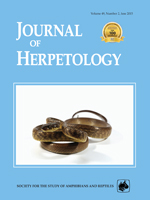Conservation measures to increase or maintain habitat networks in pond-dwelling amphibians often consist of new breeding ponds to supplement existing ones. We examined the effectiveness of this conservation measure in the European Treefrog (Hyla arborea) by evaluating the speed of colonization and the origin of colonizers using field surveys and genetic methods in an intensively managed agricultural area in Switzerland. One to three years after pond construction, 85 European Treefrogs were found at new ponds, and of these, 30 were identified as migrants by genetic assignment tests. We observed a negative correlation between the number of migrants and geographical distance (r = −0.33): 66% of colonizers originated from ponds nearby (up to 500 m); 30% stemmed from source ponds located at distances between 500 and 2,500 m; and 4% originated from distant ponds (2,500 to 5,400 m). Four colonizers crossed a 25-m wide river. These results show that Treefrogs rapidly colonize new ponds and that the gene pools at these new ponds contain a wide range of genetic variants of a Treefrog population that is patchily structured. Thus, maintaining high pond density is an efficient conservation measure to increase functional connectivity for Treefrogs even in an intensely managed agricultural landscape.
How to translate text using browser tools
1 June 2015
Increasing Pond Density to Maintain a Patchy Habitat Network of the European Treefrog ( Hyla arborea)
Gwenaëlle Le Lay,
Sonia Angelone,
Rolf Holderegger,
Christoph Flory,
Janine Bolliger
ACCESS THE FULL ARTICLE

Journal of Herpetology
Vol. 49 • No. 2
June 2015
Vol. 49 • No. 2
June 2015




